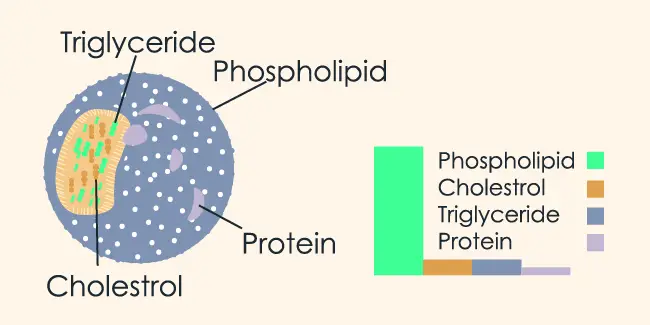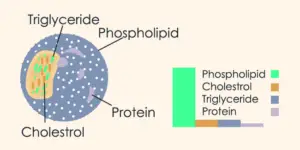
What are Chylomicrons ? A Quick and Interesting Guide.
Chylomicrons are a class of lipoproteins formed in the small intestine during the absorption of exogenous lipids. They are found in the blood and lymphatic fluid. It transports dietary lipids from the intestine to other parts of the body. It is one of the serum lipoproteins.
They form in the endoplasmic reticulum in the absorbing cells ( enterocytes ) of the small intestine. They also contain cholesterol and cholesterol esters. Five major groups of lipoproteins to the fat and cholesterol can be moved in an aqueous solution of the blood flow.
Where are chylomicrons synthesized?
Chylomicrons synthesize in the cells of the intestinal wall from where they pass into the blood plasma. Its composition is 86–94% triglycerides, 3–8% phospholipids, 0.5–1% cholesterol, and 2% special proteins called apolipoproteins. The total lipid content is 98-99%. It has the lowest density.

What is the function and catabolism of chylomicrons?
The function of Chylomicron is to transports exogenous lipids to the liver, fat, heart, and skeletal muscle tissue. At these locations, the activity of lipoprotein lipase lowers triglycerides. When most of the core of triacylglycerol has been hydrolyzed, its residues form and transfer to the liver.
The catabolism of these lipoproteins is very similar, although they synthesize in response to different conditions as follow:
- In the light of a blood vessel, lipoproteins “collide” with HDL, which transfers apoCII and apoE to them, becoming “mature particles”.In this case, the resulting fatty acids penetrate the tissue ( adipose tissue, muscles, and others), and the Apoc-II lipoprotein lipase activator again goes to HDL.
- The particle size of the chylomicron decreases and it turns into a residue.
- Its residue rapidly absorbs by the liver due to receptor binding of the endothelium with apoE and subsequent endocytosis, where it finally degrades.
- Thus, it provides the transfer of food lipids from the intestine to the liver.
Let’s dive bit more into detail about it.
What are immature, mature, and remnant types of chylo microns?
Immature chylomicron makes up of absorbing cells in the small intestine known as enterocytes. These are relatively large with diameters of 75 to 1,200 nanometers. It composed mainly of triglycerides (85%), cholesterol, and cholesterol ester. The main apolipoprotein component is apolipoprotein-48 B.
In the case of mature chylomicrons, these are circulating in lymph and blood, chylomicron exchanges components with high-density lipoprotein (HDL). HDL is apolipoprotein-II C and apolipoprotein E provides the initial chylomicrons, to convert into mature chylomicrons. APOC2 is a cofactor for lipoprotein lipase (LPL) activity.
Chylomicron Remnant: When the triglyceride reserve consumes (distributed), it converts APOC2 back to HDL (which APOE retains), leaving chylomicrons remnants of only 20-50 nm. APOB48 and APOE are important for the identification of chylomicron remnants in the liver due to endocytosis and degradation.
Let’s compare Chylomicrons with other terms.
Chylomicron vs VLDL
The chylomicrons are large lipoproteins with an extremely low density that transport dietary lipids from intestine to tissues while the VLDL, very low-density lipoproteins, synthesized in the liver and transport lipids to tissues.VLDL lose triacylglycerols and some apoproteins and phospholipids in the body.
Chylo-micron and Micelles
Micelles are aggregates of several molecules. This is in the form in which fatty acids, glycerides, sterols absorb into the intestinal cells. They made of phospholipids while Chylomicrons a type of lipoproteins that carry dietary cholesterol and triglycerides from the small intestine out to the body tissues.
Chylo-micron test
The so-called refrigerator test is a qualitative detection method for chylomicrons. In the process, fasting blood serum store overnight at 4 ° C. If a “cream layer” creates at the top, this consider positive evidence of chylomicrons. While homogeneous turbidity indicates an increased concentration of VLDL.